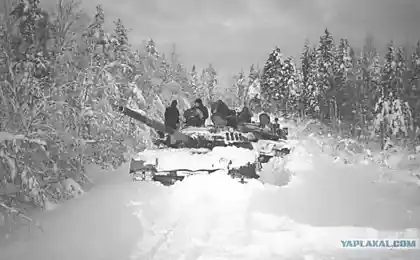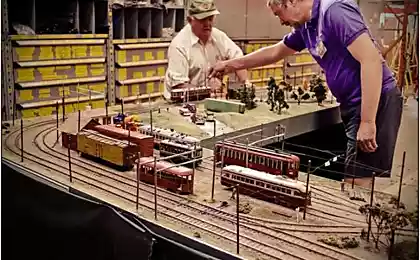963
501 Construction
Back in adolescence, we went on a boat to pick mushrooms. And when that has not been lodged description. In the middle of the river, from island to island, the water hanging rails. As a child of curiosity, I began to ask questions. But the answer is not achieved. Mother pulling me by the arm, hissed that such things do not ask out loud if you do not want trouble. The child I was smart questions to ask ceased.
Many years have passed, the period of publicity, etc. Now you can learn all about it. That son even essay on the subject writes. He decided to take a bit of material, and to tell you about the past.
22 photo.

Construction of the railway along the Arctic Circle Salekhard - Igarka,
also known as "dead road", it can be considered one of the most ambitious projects of the Gulag.
April 22, 1947 the Council of Ministers in a secret decree of №1255-331-MOP decided to proceed with the construction of a major seaport in the Ob Bay near Cape Stone and the railway from the station. Chum (south of Vorkuta) to the port. The need for construction of the railway was caused by two factors: the economic - development of the northern territory, rich in minerals and military strategy - the protection of the Arctic coast. The idea of building owned by Stalin himself: "It is necessary to take on the North, the North Siberia, undisguised, and the political situation is very dangerous." Construction was assigned to the General Directorate of railway construction camp (GULZhDS) logon Gulag. The main labor force were prisoners and exiles. Were a small number of civilian and mainly engaged in management positions.
By the end of 1948 it was built branch Chum - Labytnangi (village at the mouth of the Ob) length of 196 km. By this time it was found out that in the area of Cape Stone construction seaport impossible because of the hydrogeological characteristics. However, the idea of creating polar port on the Northern Sea Route is not abandoned. It was suggested to move to the area of the port of Igarka (north of Krasnoyarsk Territory), which required to continue the line Chum - Labytnangi east. There were two construction management: №501 the center of Salekhard and Igarka №503 (control rooms had, as the building was classified). Construction of the railway was carried out to meet each other.
According to archival sources estimated the number of inmates in the entire road Salekhard - Igarka ranged from 80 to 100 thousand.
Despite the harsh environmental conditions: frost below 50 degrees, marshes, roads, midges, the road was constructed rapidly. By the beginning of 1953 it was built around 800 km from the projected 1482 km. On the western segment it was completely built branch Chum - Salekhard. From Salekhard to Nadym it was opened by the labor movement. In the central sector - from Hetta to r.Pur r.Bolshaya it was laid 150 km of roadbed. In the eastern sector - from Yermakovo to Yanov Stan on r.Turuhan - it opened the labor movement. On the rivers Ob and Yenisei operated ferry-ice crossing. It remained unfinished building between the central portion Purom and pelvis. In 1953, shortly after the death of Stalin, the government decided on the construction of conservation and its subsequent liquidation.
Unlike other "great construction projects of communism" Northern Railway were dead expensive. The construction has been spent several billion rubles. On its liquidation only in 1953 it was spent 78 million. P. (prices of the time). But a huge amount of wealth and could not take (due to remoteness from settlements and the lack of transport). Much of the equipment, furniture, clothing destroyed in the eyes of the inhabitants of Jean-d.poselkov. Locomotives were abandoned, empty barracks, kilometers of barbed wire and thousands of dead prisoners-builders, the price of life that defies any accounting.
Now Railway route Salekhard - Igarka similar zone of Tarkovsky film "Stalker": permafrost mangled tracks, reared bridges washed away embankments, destroyed huts, overturned locomotives.
In March 1947, in accordance with the February of the same year the Council of Ministers of the USSR, 501 th General Management Control camps (Gulag), is engaged in construction of the railway rolling up his sleeves start laying the 700-kilometer route from the station Chum road Kotlas - Vorkuta in the north east across the Shchuchye and New Port on Cape Stone. To do this the perfect uninhabited places in a hurry columns of prisoners were brought - mainly in Article 58.
Among many other Stalin's "great projects" (the White Sea Canal, Volgokanal, railway Kotlas - Vorkuta sites Baikal-Amur Mainline, etc..) Epic construction of the Salekhard - Igarka allocated special crudity and deliberate meaninglessness. Hastily launched on the orders of senior management of the country's construction was completely unprepared and engineering, and from an organizational point of view.
But it is difficult geological and climatic conditions have not prevented by the end of 1948 to put the train on the 200-kilometer stretch of the road, cross the foothills of the Polar Urals from the station to the village of Chum Labytnangi on the banks of the Ob River. According to the plans of management of the Gulag, for 1952 - 1953 years the builders of both departments were supposed to meet on the banks of the river Pur, about the middle of the 1300-kilometer route. However, the further implementation of the grand plan has stalled, - in the midst of construction revealed that the new port will not be able to enter the ocean ships.
A March 25, 1953 20 days after the death of Stalin, the USSR Council of Ministers decided to stop the construction of the Stalin Railway. Prisoners work for months after that, doing the dismantling, pulling crutches and rails.
There is no official data on the number of fatalities in the construction. An approximate count range from 60 to 100 thousand. Man.

Two
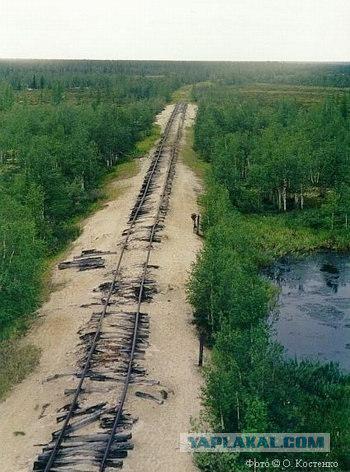
Three

Four
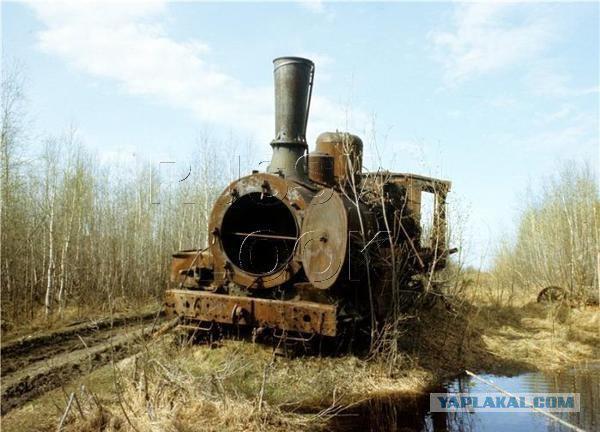
Five
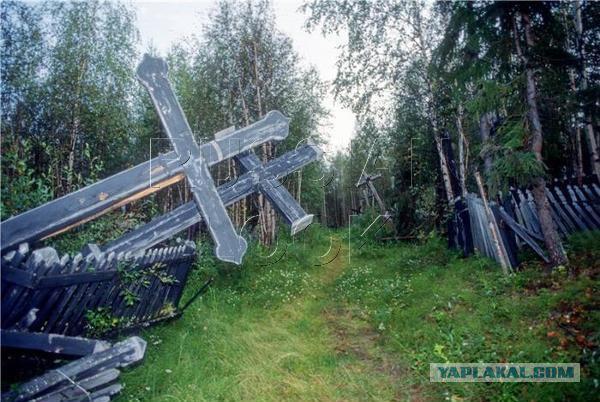
Six
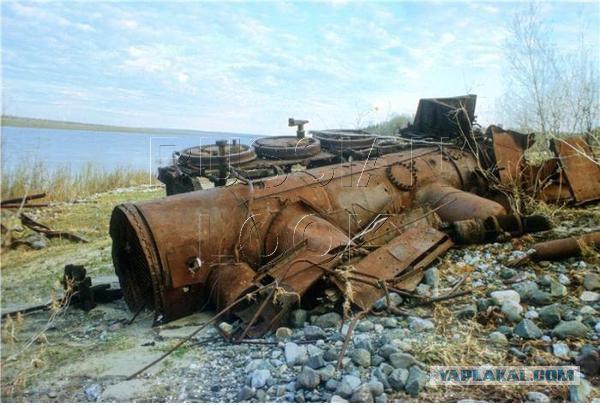
Seven
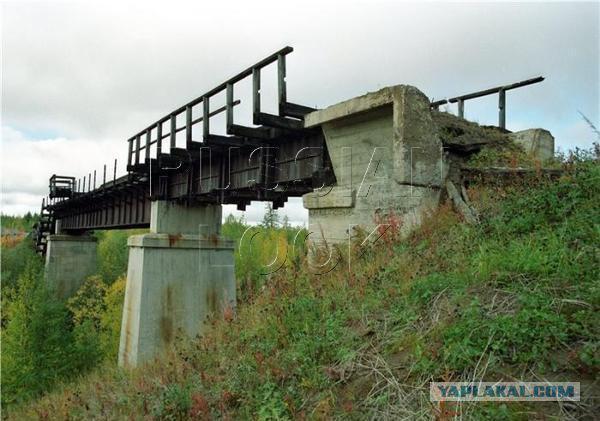
eight

nine

Ten
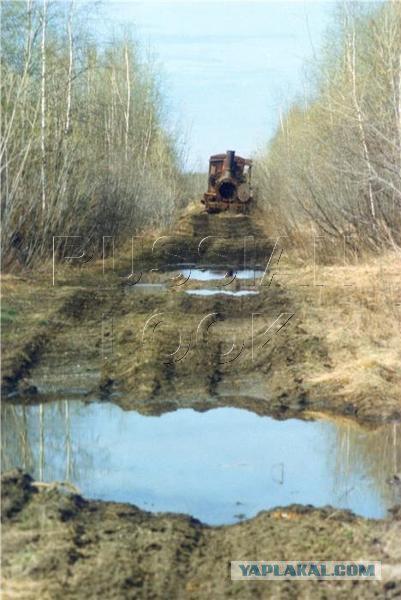
11 ...
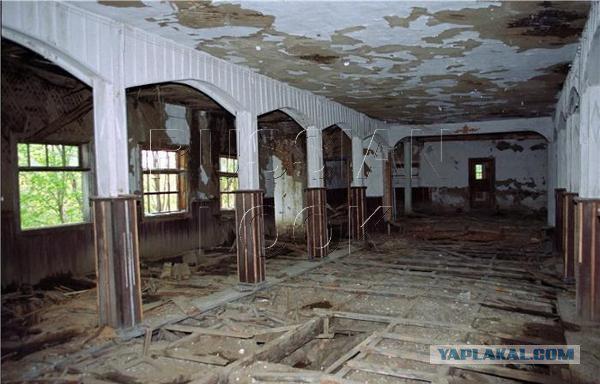
12 ...
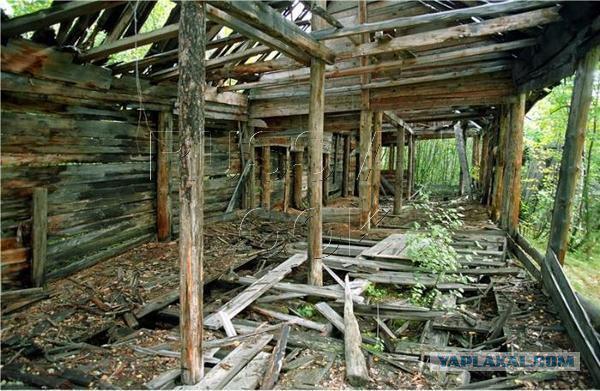
13 ...

14 ...

15 ...

16 ...
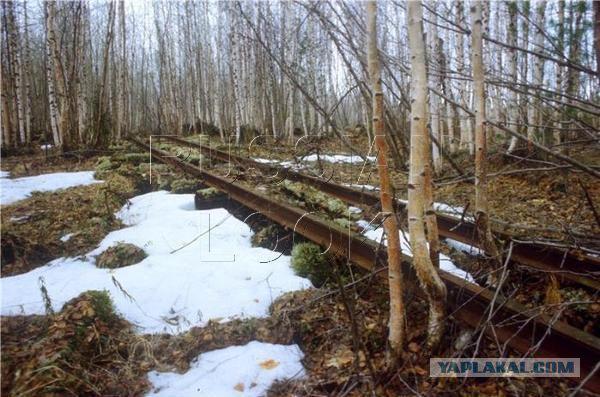
17 ...
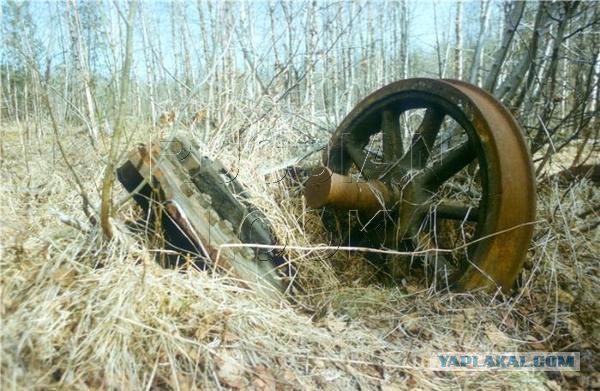
18 ...

19 ...
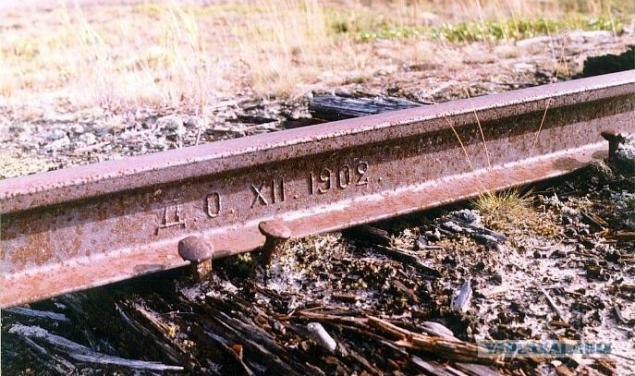
20 ...
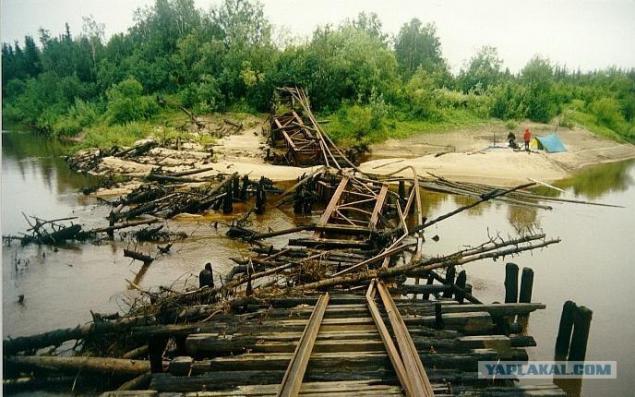
This monument, the same locomotive
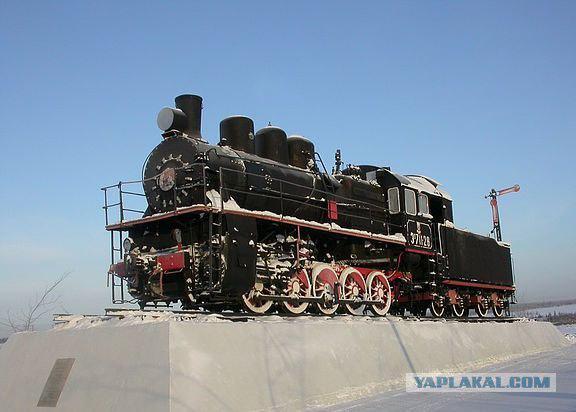
22.

Source:
Many years have passed, the period of publicity, etc. Now you can learn all about it. That son even essay on the subject writes. He decided to take a bit of material, and to tell you about the past.
22 photo.

Construction of the railway along the Arctic Circle Salekhard - Igarka,
also known as "dead road", it can be considered one of the most ambitious projects of the Gulag.
April 22, 1947 the Council of Ministers in a secret decree of №1255-331-MOP decided to proceed with the construction of a major seaport in the Ob Bay near Cape Stone and the railway from the station. Chum (south of Vorkuta) to the port. The need for construction of the railway was caused by two factors: the economic - development of the northern territory, rich in minerals and military strategy - the protection of the Arctic coast. The idea of building owned by Stalin himself: "It is necessary to take on the North, the North Siberia, undisguised, and the political situation is very dangerous." Construction was assigned to the General Directorate of railway construction camp (GULZhDS) logon Gulag. The main labor force were prisoners and exiles. Were a small number of civilian and mainly engaged in management positions.
By the end of 1948 it was built branch Chum - Labytnangi (village at the mouth of the Ob) length of 196 km. By this time it was found out that in the area of Cape Stone construction seaport impossible because of the hydrogeological characteristics. However, the idea of creating polar port on the Northern Sea Route is not abandoned. It was suggested to move to the area of the port of Igarka (north of Krasnoyarsk Territory), which required to continue the line Chum - Labytnangi east. There were two construction management: №501 the center of Salekhard and Igarka №503 (control rooms had, as the building was classified). Construction of the railway was carried out to meet each other.
According to archival sources estimated the number of inmates in the entire road Salekhard - Igarka ranged from 80 to 100 thousand.
Despite the harsh environmental conditions: frost below 50 degrees, marshes, roads, midges, the road was constructed rapidly. By the beginning of 1953 it was built around 800 km from the projected 1482 km. On the western segment it was completely built branch Chum - Salekhard. From Salekhard to Nadym it was opened by the labor movement. In the central sector - from Hetta to r.Pur r.Bolshaya it was laid 150 km of roadbed. In the eastern sector - from Yermakovo to Yanov Stan on r.Turuhan - it opened the labor movement. On the rivers Ob and Yenisei operated ferry-ice crossing. It remained unfinished building between the central portion Purom and pelvis. In 1953, shortly after the death of Stalin, the government decided on the construction of conservation and its subsequent liquidation.
Unlike other "great construction projects of communism" Northern Railway were dead expensive. The construction has been spent several billion rubles. On its liquidation only in 1953 it was spent 78 million. P. (prices of the time). But a huge amount of wealth and could not take (due to remoteness from settlements and the lack of transport). Much of the equipment, furniture, clothing destroyed in the eyes of the inhabitants of Jean-d.poselkov. Locomotives were abandoned, empty barracks, kilometers of barbed wire and thousands of dead prisoners-builders, the price of life that defies any accounting.
Now Railway route Salekhard - Igarka similar zone of Tarkovsky film "Stalker": permafrost mangled tracks, reared bridges washed away embankments, destroyed huts, overturned locomotives.
In March 1947, in accordance with the February of the same year the Council of Ministers of the USSR, 501 th General Management Control camps (Gulag), is engaged in construction of the railway rolling up his sleeves start laying the 700-kilometer route from the station Chum road Kotlas - Vorkuta in the north east across the Shchuchye and New Port on Cape Stone. To do this the perfect uninhabited places in a hurry columns of prisoners were brought - mainly in Article 58.
Among many other Stalin's "great projects" (the White Sea Canal, Volgokanal, railway Kotlas - Vorkuta sites Baikal-Amur Mainline, etc..) Epic construction of the Salekhard - Igarka allocated special crudity and deliberate meaninglessness. Hastily launched on the orders of senior management of the country's construction was completely unprepared and engineering, and from an organizational point of view.
But it is difficult geological and climatic conditions have not prevented by the end of 1948 to put the train on the 200-kilometer stretch of the road, cross the foothills of the Polar Urals from the station to the village of Chum Labytnangi on the banks of the Ob River. According to the plans of management of the Gulag, for 1952 - 1953 years the builders of both departments were supposed to meet on the banks of the river Pur, about the middle of the 1300-kilometer route. However, the further implementation of the grand plan has stalled, - in the midst of construction revealed that the new port will not be able to enter the ocean ships.
A March 25, 1953 20 days after the death of Stalin, the USSR Council of Ministers decided to stop the construction of the Stalin Railway. Prisoners work for months after that, doing the dismantling, pulling crutches and rails.
There is no official data on the number of fatalities in the construction. An approximate count range from 60 to 100 thousand. Man.

Two

Three

Four

Five

Six

Seven

eight

nine

Ten

11 ...

12 ...

13 ...

14 ...

15 ...

16 ...

17 ...

18 ...

19 ...

20 ...

This monument, the same locomotive

22.

Source:







